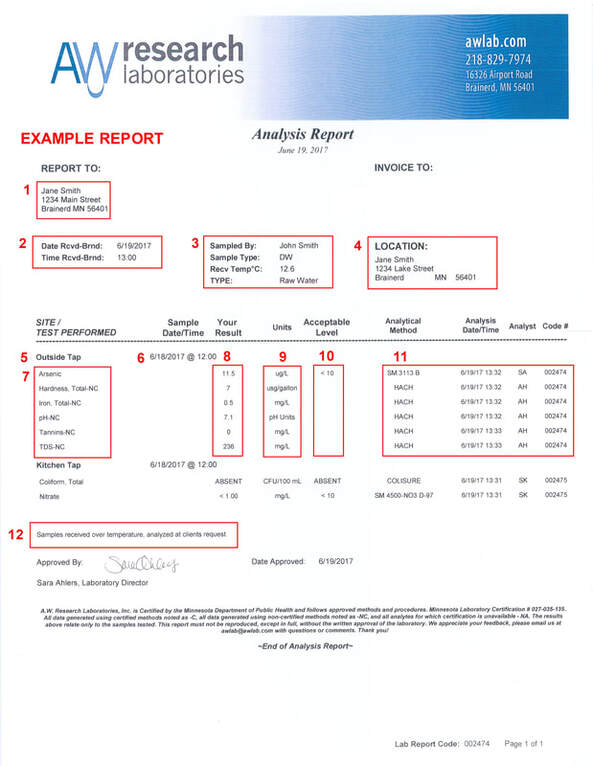You've received your results! Now what does it all mean?
We get it! Lab reports can be confusing if you're not used to reading them, so here's some information to help you understand your report.
The report below is an EXAMPLE. Refer to the numbered list to interpret each section of the report.
We get it! Lab reports can be confusing if you're not used to reading them, so here's some information to help you understand your report.
The report below is an EXAMPLE. Refer to the numbered list to interpret each section of the report.
Still have questions? Give us a call, we're happy to help! 218-829-7974
|
Your ResultsYour results for each test are listed on the report under the Your Result column. Compare that number to the number in the Acceptable Level column to know if your result is considered safe for human consumption.
For example, in the report above the arsenic result is 11.5 ug/L. The Acceptable Level is < 10 ug/L (less than 10 ug/L), so the arsenic in this water is too high to be considered safe for drinking. NOTE: Not all parameters have an Acceptable Level. The EPA establishes safe drinking water requirements for contaminants that have been shown to have negative impacts on human health. The EPA does not set safe drinking requirements for some parameters such as Iron and Hardness. These parameters have "Secondary Standards" established for aesthetic reasons. See table below for these values: |
|
Test Completed |
Secondary Standard |
Noticeable Effects above Secondary Standard |
Iron |
0.3 mg/L |
rusty color; sediment; metallic taste; reddish or orange staining |
Hardness |
None Established Click here for Hardness Scale |
deposits; scaling; requires more soap |
Total Dissolved Solids (TDS) |
500 mg/L |
hardness; deposits; colored water; staining; salty taste |
Tannins |
None Established |
brown color; reddish or brown staining |
pH |
6.5-8.5 |
low pH: bitter metallic taste; corrosion high pH: slippery feel; soda taste; deposits |
Still have questions? Give us a call, we're happy to help! 218-829-7974
Next Steps
If your results came back too high or unacceptable here are some next steps to get your water back to safe levels:
|
Total Coliform Bacteria
If you receive a "present" (aka. "positive") result, the water should not be consumed unless it is first brought to a rolling boil for at least one minute, or the well is chlorinated. Once the well has been chlorinated, another test should be done to confirm that total coliform is no longer present before the water is considered safe to drink. If your sample tested positive for total coliform bacteria, you will receive a packet in the mail with more information and a bottle for your retest sample. Nitrates
If your water has greater than 10.0 mg/L of nitrates, you will need to install a treatment system such as ion exchange or a reverse osmosis system. Contact a water treatment professional for more information. Arsenic
It's up to the homeowner to determine at what point they will treat their water for arsenic. Treatment systems that are able to remove arsenic include ion exchange and reverse osmosis systems. Contact a water treatment professional for more information. |
Lead
The simplest method to reduce lead exposure from drinking water is to turn on the cold water tap each morning, and let it run for a minute or two, until the water gets cold. This will "flush" the water that is standing in the plumbing pipes and components. You should do this for all faucets used for drinking and cooking. Flush the system any time the water has not been used for six hours or longer. In addition, hot water dissolves lead and copper more quickly than cold water; as a result, water to be used for drinking or cooking should not be drawn from the hot water tap. If you need hot water for cooking or drinking, take water from the cold tap and heat it. It is especially important not to use hot tap water for making baby formula. Once any treatment system has been installed it is important to monitor your water on a regular basis to ensure the system is removing the desired amount of the contaminant of concern.
|
For More Information
Click on the links below to download fact sheets from the Minnesota Department of Health.
| Coliform Bacteria Fact Sheet | |
| File Size: | 29 kb |
| File Type: | |
| Nitrate Fact Sheet | |
| File Size: | 103 kb |
| File Type: | |
| Arsenic Fact Sheet | |
| File Size: | 21 kb |
| File Type: | |
| Lead & Copper Fact Sheet | |
| File Size: | 28 kb |
| File Type: | |
Still have questions? Give us a call, we're happy to help! 218-829-7974



